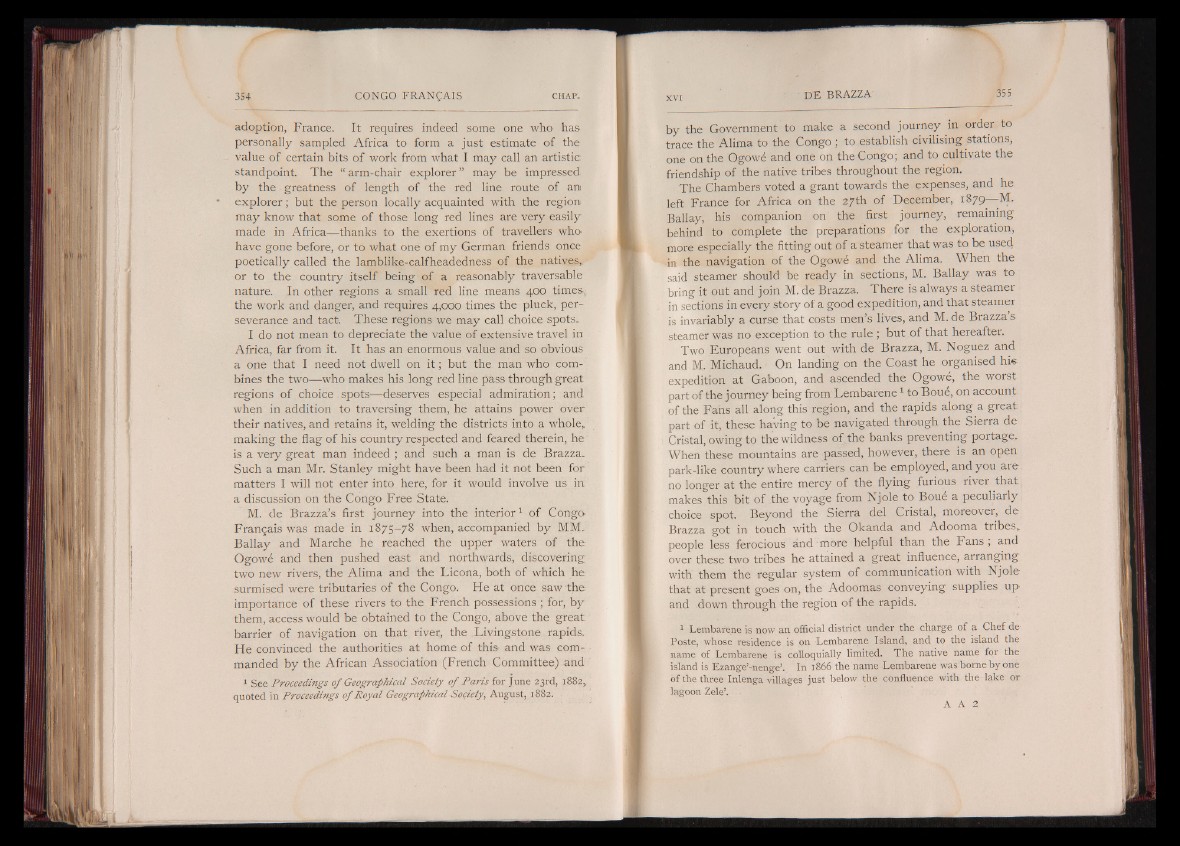
adoption, France. It requires indeed some one who has.
personally sampled Africa to form a just estimate of the
value of certain bits of work from what I may call an artistic
standpoint. The “ arm-chair explorer” may be impressed,
by the greatness of length of the red line route of am
explorer ; but the person locally acquainted with the region
may know that some of those long red lines are very easily
made in Africa— thanks to the exertions of travellers who
have gone before, or to what one of my German friends once
poetically called the lamblike-calfheadedness of the natives,,
or to the country itself being of a reasonably traversable
nature. In other regions a small red line means 400 times,
the work and danger, and requires 4,000 times the pluck, perseverance
and tact. These regions we may call choice spots.
I do not mean to depreciate the value of extensive travel in
Africa, far from it. It has an enormous value and so obvious
a one that I need not dwell on it ; but the man who combines
the two— who makes his long red line pâss through great
regions of choice . spots— deserves especial admiration ; and
when in addition to traversing them, he attains power over
their natives, and retains it, welding the districts into a whole,
making the flag of his country respected and feared therein, he
is a very great man indeed ; and such a man is de Brazza.
Such a man Mr. Stanley might have been had it not been for
matters I will not enter into here, for it would involve us in
a discussion on the Congo Free State.
M. de Brazza’s first journey into the interior1 of Congo.
Français was made in 1875-78 when, accompanied by MM.
Ballay and Marche he reached the upper waters of the
Ogowé and then pushed east and northwards, discovering
two new rivers, the Alima and the Licona, both of which he
surmised were tributaries of the Congo. He at once saw the
importance of these rivers to the French possessions ; for, by
them, access would be obtained to the Congo, above the great
barrier of navigation on that river, the Livingstone rapids.
He convinced the authorities at home of this- and was commanded
by the African Association (French Committee) and
1 See Proceedings o f Geographical Society of Paris for June 23rd, 1882,
quoted in Proceedings of Royal Geographical Society, August, 1882.
by the Government to make a second journey in order to
trace the Alima to the Congo ; to establish civilising stations,
one on the Ogowe and one on the Congo; and to cultivate the
friendship of the native tribes throughout the region.
The Chambers voted a grant towards the expenses, and he
left France for Africa on the 27th of December, 1879— M.
Ballay, his companion on the first journey, remaining
behind to complete the preparations for the exploration,
more especially the fitting out of a steamer that was to be used
in the navigation of the Ogowe and the Alima. When the
said steamer should be ready in sections, M. Ballay was to
bring it out and join M. de Brazza. There is always a steamer
in sections in every story of a good expedition, and that steamer
is invariably a curse that costs men’s lives, and M. de Brazza s
steamer was no exception to the rule ; but of that hereafter.
Two Europeans went out with de Brazza, M. Noguez and
and M. Michaud. On landing on the Coast he organised hi«
expedition at Gaboon, and ascended the Ogowe, the worst
part of the journey being from Lembarene1 to Boue, on account
of the Fans all along this region, and the rapids along a great
part of it, these having to be navigated through the Sierra de
Cristal, owing to the wildness of the banks preventing portage.
When these mountains are passed, however, there is an open
park-like country where carriers can be employed, and you are.
no longer at the entire mercy of the flying furious river that;
makes this bit of the voyage from Njole to Boue a peculiarly
choice spot. Beyond the Sierra del Cristal, moreover, de
Brazza got in touch with the Okanda and Adooma tribes,,
people less ferocious and 1 more helpful than the Fans, and
over these two tribes he attained a great influence, arranging
with them the regular system of communication with Njole
that at present goes on, the Adoomas conveying supplies up
and down through the region of the rapids.
1 Lembarene is now an official district under the charge of a Chef de
Poste, whose residence is on Lembarene Island, and to the island the
name of Lembarene is colloquially limited. The native name for the
island is Ezange’-nenge’. In 1866 the name Lembarene was borne by one
of the three Inlenga villages just below the confluence with the lake or
lagoon Zele’.